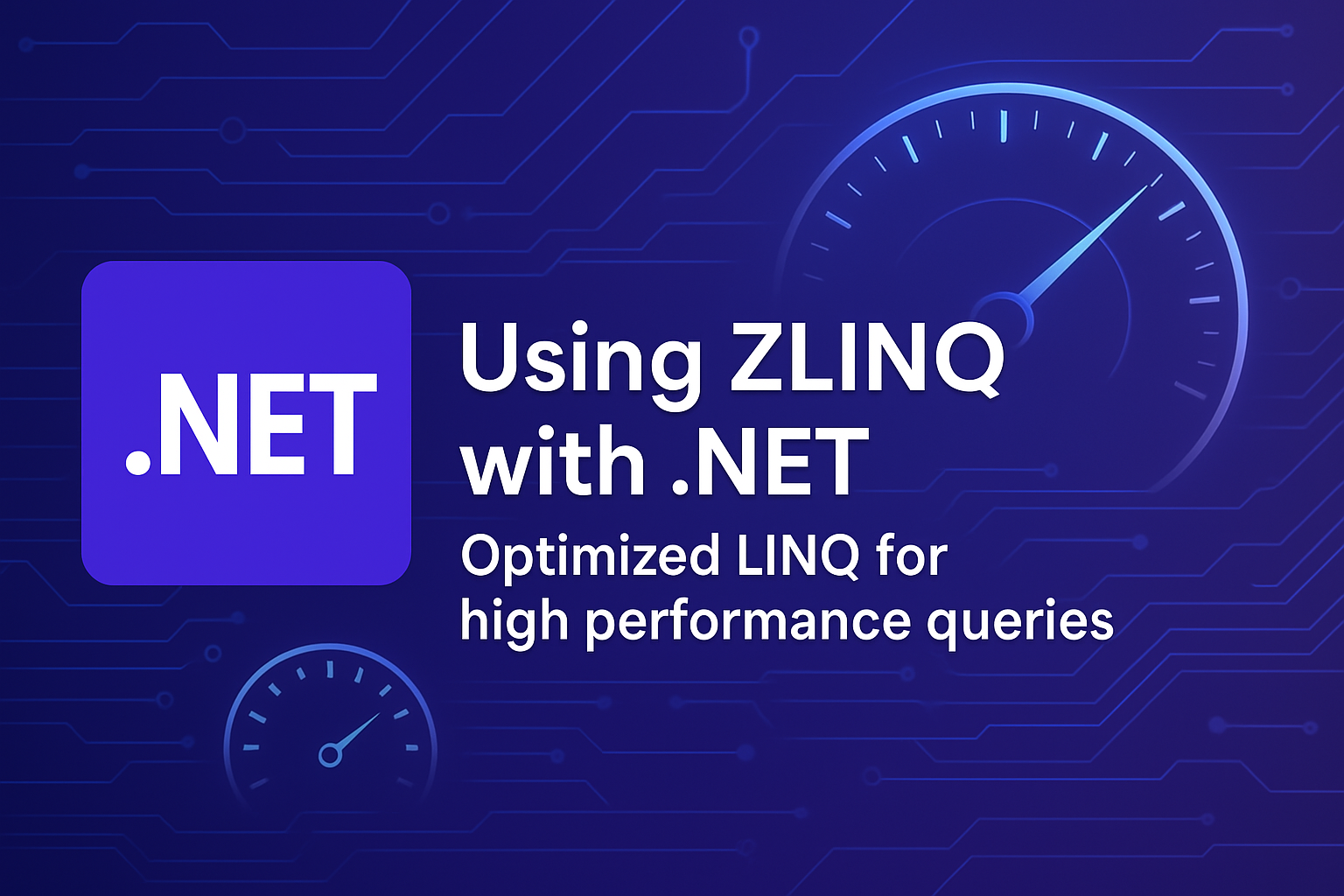As the demand for faster and more efficient collection queries increases in .NET applications, many developers are exploring alternatives to standard LINQ. One such option is ZLINQ - a library that offers a LINQ-compatible API with a focus on high performance and zero allocations. It's perfect for data-heavy systems, real-time services, and modern microservices.
In this article, you'll learn what ZLINQ is, how to use it in a modern .NET project, and when to choose it over standard LINQ.
What is ZLINQ?
ZLINQ refers to performance-focused LINQ alternatives such as StructLINQ, Z.Linq, or similar libraries. These libraries aim to replace System.Linq with an implementation that avoids allocations using struct-based enumerators and optimized query pipelines.
⚠️ Note: "ZLINQ" may refer to different libraries depending on the context. This article uses StructLINQ as a representative example for high-performance LINQ alternatives.
Why choose ZLINQ?
✅ Zero heap allocations (perfect for high-performance scenarios)
✅ Uses
struct enumeratorsto avoid boxing overhead✅ Up to 10x faster in benchmarks compared to traditional LINQ
✅ Fully compatible with existing pipelines and
foreachloops✅ Ideal for games, IoT, trading systems, and real-time APIs
✅ Better CPU cache locality due to value types
Installation
Install StructLINQ via NuGet:
dotnet add package StructLinq
Or for Z.Linq:
dotnet add package Z.Linq
LINQ vs ZLINQ comparison
Traditional LINQ example
var numbers = Enumerable.Range(0, 1000);
var evenNumbers = numbers.Where(n => n % 2 == 0).ToList();
ZLINQ (StructLINQ) example
using StructLinq;
var numbers = StructEnumerable.Range(0, 1000);
var evenNumbers = numbers
.Where(x => x % 2 == 0)
.ToList(); // Still allocates for the list, but enumeration is optimized
// Allocation-free version (no intermediate collections)
var evenSum = StructEnumerable.Range(0, 1000)
.Where(x => x % 2 == 0)
.Sum();
How does ZLINQ work?
ZLINQ-style libraries achieve superior performance through:
ref structenumerators to avoid heap allocationsPipelined execution with value types
JIT optimizations (especially effective in .NET 6+ and .NET 7+)
Inlining of delegate calls where possible
Stack-based enumeration instead of heap-based
Performance benchmark
Performance comparison results:
Where + Sum operations:
Standard LINQ: ~18 µs
StructLINQ (ZLINQ): ~3.5 µs ⚡️ (5x faster)
Select + ToList operations:
Standard LINQ: ~22 µs
StructLINQ (ZLINQ): ~4.0 µs ⚡️ (5.5x faster)
Memory allocations:
Standard LINQ: High heap allocations 📈
StructLINQ (ZLINQ): Zero or minimal allocations 🎯
Benchmark tested in .NET 7 using BenchmarkDotNet with integer arrays of 1000 elements
When to use ZLINQ?
Perfect for:
Working with large in-memory datasets
Applications requiring low latency and high throughput
Hot paths in performance-critical code
Game development and real-time systems
Scientific computing and data analysis
Microservices with high request volumes
Target Environments:
.NET 5+ (optimal performance)
.NET 6 or newer (best JIT optimizations)
Considerations before adopting
Potential Drawbacks:
Slightly more verbose syntax compared to standard LINQ
Not all LINQ operators are available (depends on the library)
May require struct-aware refactoring of existing code
Limited IntelliSense support in some IDEs
Learning curve for developers unfamiliar with struct-based APIs
Complete example with StructLINQ
using StructLinq;
using System;
using System.Diagnostics;
class Program
{
static void Main()
{
const int dataSize = 1_000_000;
// Traditional LINQ
var sw = Stopwatch.StartNew();
var linqResult = Enumerable.Range(0, dataSize)
.Where(x => x % 5 == 0)
.Select(x => x * 3)
.Sum();
sw.Stop();
Console.WriteLine($"LINQ result: {linqResult} in {sw.ElapsedMilliseconds}ms");
// StructLINQ (ZLINQ-style)
sw.Restart();
var structLinqResult = StructEnumerable.Range(0, dataSize)
.Where(x => x % 5 == 0)
.Select(x => x * 3)
.Sum();
sw.Stop();
Console.WriteLine($"StructLINQ result: {structLinqResult} in {sw.ElapsedMilliseconds}ms");
}
}
Decision matrix: ZLINQ vs traditional LINQ
Choosing between Standard LINQ and ZLINQ/StructLINQ:
Readability & ease of use:
Standard LINQ: ✅ Simple and intuitive syntax
ZLINQ/StructLINQ: ⚠️ Slightly more complex, requires struct understanding
Runtime performance:
Standard LINQ: ⚠️ Moderate performance, good for most cases
ZLINQ/StructLINQ: ✅ Excellent performance, optimized for speed
Memory allocations:
Standard LINQ: ⚠️ Can generate high heap allocations
ZLINQ/StructLINQ: ✅ Near-zero allocations, stack-based
.NET compatibility:
Standard LINQ: ✅ Full support across all .NET versions
ZLINQ/StructLINQ: ⚠️ Requires .NET Core/5+ for optimal performance
Development speed:
Standard LINQ: ✅ Fast prototyping, well-known patterns
ZLINQ/StructLINQ: ⚠️ Requires more consideration and planning
Maintenance:
Standard LINQ: ✅ Well-known patterns, easy to maintain
ZLINQ/StructLINQ: ⚠️ Specialized knowledge needed for team
Migration strategy
When migrating from LINQ to ZLINQ:
Profile first - Identify actual performance bottlenecks
Start small - Replace hot paths gradually
Benchmark everything - Measure real-world performance gains
Team training - Ensure team understands struct-based patterns
Fallback plan - Keep standard LINQ for complex queries
Connect with me
If you work with modern .NET and want to master performance optimization, C#, DevOps, or system interoperability — let's connect:
Final thoughts
ZLINQ, particularly libraries like StructLINQ, represents a powerful tool for developers who need to extract maximum performance from their .NET applications. Whether you're building real-time APIs, high-throughput services, or data-intensive applications, ZLINQ can be a valuable optimization ally.
The key is understanding when the performance benefits justify the added complexity. For most applications, standard LINQ is perfectly adequate. However, when you're dealing with performance-critical scenarios, ZLINQ can provide the edge you need.



